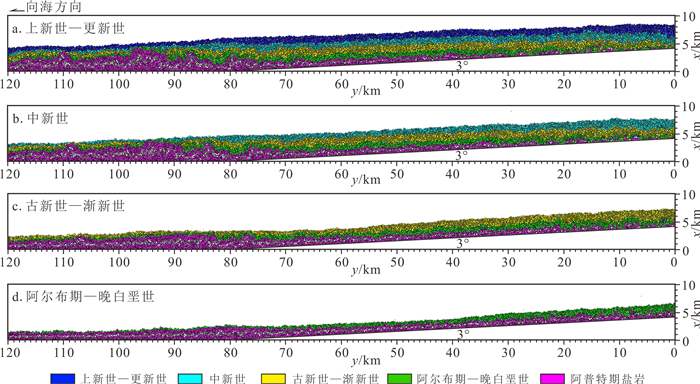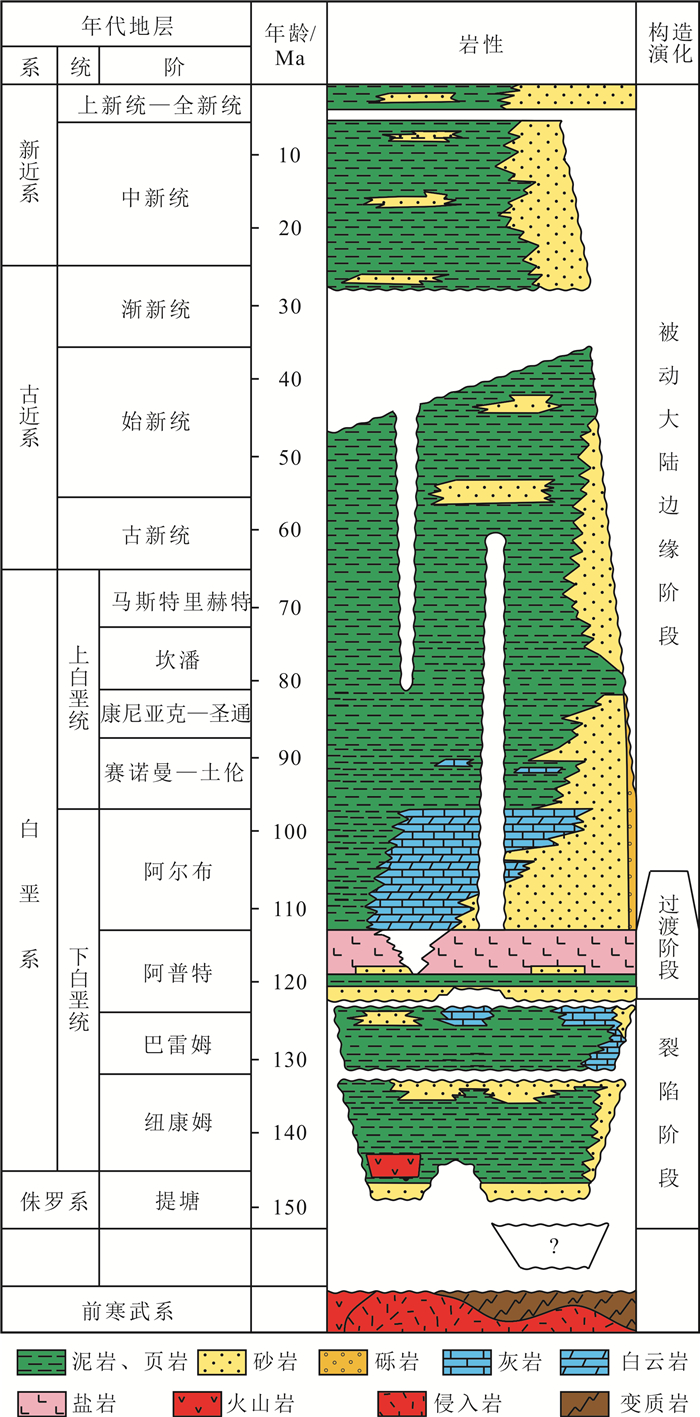2. 北京大学地球与空间科学学院, 北京 100871;
3. 北京大学石油与天然气研究中心, 北京 100871;
4. 中海石油天津分公司渤海石油研究院, 天津 300452;
5. 中国石化石油勘探开发研究院, 北京 100083
2. School of Earth and Space Sciences, Peking University, Beijing 100871, China;
3. Institute of Oil and Gas, Peking University, Beijing 100871, China;
4. Bohai Oilfield Research Institute of CNOOC Ltd., Tianjin 300452, China;
5. Sinopec Petroleum Exploration and Production Research Institute, Beijing 100083, China
0 引言
下刚果盆地盐构造的演化变形不断改造着上覆地层,对油气在不同地质时期的成藏有重要的控制作用。前人通过平衡剖面方法,开展了下刚果盆地等含盐盆地的盐构造演化阶段分析[1-3],提出了多种构造恢复方法[4-5]。然而,由于盐岩流动的不规律性[6],研究结果仅能对断裂等构造演化完成定量恢复,对于不同时期盐岩构造形态,其刻画的准确性仍存在明显的不足。Adam等[7]结合物理模拟方法,基于对模拟的最终模拟结果,完成了对南大西洋两岸被动陆缘盆地不同构造区的盐构造变形特征的分析,其虽对模型的平面演化进行了记录,但仅能记录大规模的底辟构造和盐岩相关褶皱构造,无法确定盐岩在不同时期实际的构造特征。应用数值模拟方法能够记录盐岩不同演化时间的构造特征,研究中开展了不同因素对盐构造形成的影响,包括盐上层的密度、盐上层和盐岩层的密度差[8]、盐上层的厚度[9]、基底形态[10]、构造倾斜角度[11]等,但是并未对盐构造的形成演化展开分析。因此,本文结合数值模拟手段,采用盐上沉积地层分阶段加载的方式,正演了下刚果盆地的形成演化过程,以明确各阶段盐构造的形成演化过程,提升了其演化期次的认识。
1 地质背景下刚果盆地位于安哥拉西部,属于西非大陆边缘的含盐盆地(图 1)。其中,以刚果河入口为界,下刚果盆地可分为南、北两个部分,北部位于刚果海岸,南部位于安哥拉海岸[12-14],总面积超过1.68×105 km2,最大水深超过3 500 m[15]。下刚果盆地是南大西洋的中段盆地,其形成源于早白垩世南大西洋的张开,作为大陆裂谷系统的一部分随之演化[16-17]。下刚果盆地的油气储量约占西非海岸油气总储量的30%,是南大西洋两岸最富含油气的盆地之一[18-19],随着近些年油气储量的不断发现,下刚果盆地已经成为油气勘探的热点区域。截至2016年底,下刚果盆地盐上油气可采储量266.9亿桶,盐下油气可采储量26.6亿桶[20],油气资源潜力巨大。其中,盐岩构造作用形成的圈闭,控制了盆地90%以上的盐上油气可采储量[19]。在盐岩流动的过程中,盐岩发生变形不断地改造着上覆沉积地层,形成了多种构造组合,并控制了油气的运、聚。
下刚果盆地是早白垩世时期南大西洋张开形成的被动大陆边缘盆地[21],在盆地形成的过渡阶段(阿普特期)发育了厚层的蒸发岩[22]。以盐岩为界,盆地主要沉积地层分为盐上层、盐层和盐下层[23],盐下层主要为河流、湖泊沉积物,盐上层主要是海相碳酸盐岩沉积物[24](图 2)。盆地在阿尔布期的沉积以碳酸盐岩为主;阿尔布期至晚白垩世沉积了泥灰岩和黏土,并主要沉积了晚白垩世的硅质碎屑岩;晚白垩世至新生代的沉积物,在结构样式上主要受阿普特阶盐岩的重力滑动控制[25]。
被动大陆边缘阶段的早期,薄陆壳和年轻洋壳迅速冷却,密度增大,下沉,整个大陆边缘形成向海方向的基底倾斜,促使了盐岩流动形成盐构造[11];盐构造的形成过程中,对上覆沉积地层有明显的改造作用,伴随着大量的断裂发育[26]。被动大陆边缘阶段的阿尔布期,浅层的碳酸盐岩在大陆坡位置堆积,并逐渐向海底扩展,到达宽阔的海底位置时,碳酸盐岩沉积停止;而塞诺曼期—始新世,下刚果盆地的沉积速率较低[27-28]。早渐新世,整个西非地区发生了被定义为“渐新统不整合”的沉积事件[29],海底侵蚀作用去除了外陆架约500 m厚的沉积物[30]。同时,刚果海底扇逐渐发育,物源沉积速率明显增大[31]。这种沉积背景下,下刚果盆地康尼亚克阶—始新统(沉积时间长度约为55 Ma)表现为薄的地层[32],在地震剖面上特征明显(图 3)。

|
| a.地震剖面图;b.构造解译图。Aptian为阿普特阶。 图 3 下刚果盆地地震剖面及构造解译 Fig. 3 Seismic profile and structural interpretation of the Lower Congo basin |
|
|
离散元法采用的是时步有限差分法来求解系统中所有质点的牛顿运动方程[33]:
 (1)
(1)  (2)
(2) 式中:p为不同的运动颗粒;Fp为每个颗粒上的作用力,N;mp为质量,kg;x″p为颗粒的线性加速度,m/s2;Mp为力矩,N·m;Ip为转动惯量,kg·m2;θ″p为颗粒的角加速度,rad/s2。
当模拟进行时,离散颗粒的移动造成了颗粒与颗粒之间的相互作用,此时,颗粒接触力和位移会交替计算,造成了颗粒净力的不断改变,直至计算达到平衡状态。在任意时刻,每个小球所受的外力是此时刻周围小球对它作用力的矢量和(图 4a)。
 (3)
(3) 式中:fc为周围小球的作用力;c为周缘接触小球的个数。其中,颗粒间接触符合Hertz-Mindlin准则[34],颗粒间的接触应力可转化为正应力和剪切应力(图 4b):
 (4)
(4)  (5)
(5) 式中:fn和fs分别代表正应力和剪切应力;δn和δs分别代表颗粒间正向和切向上的接触量;kn和ks分别为颗粒间正向黏结系数和切向黏结系数(图 4c)。
通过对应岩石物理学参数可设定球体颗粒黏结系数大小。剪切应力大小与颗粒间的摩擦系数相关,当颗粒间的黏结强度被破坏后,颗粒间的运动遵循滑动接触,即符合摩擦效应。
2.2 几何模型及参数设定本次数值模拟研究,设定了长120 km、高10 km的边界模型,模型的构造倾斜角度为3°[36]。沉积层位为盐岩层和盐上层,盐上层沉积按照4个时期进行分层加载。考虑到阿尔布阶、古新统和始新统较薄[32],设定的4个时期分别为:阿尔布期—晚白垩世(113~66 Ma)、古新世—渐新世(66~23 Ma)、中新世(23~5 Ma)、上新世—更新世(5~0.01 Ma)。在下刚果盆地地震剖面上,这4个时期的地层也具有相近的平均厚度(图 5),地层在由陆向海方向,厚度逐渐减小,盐岩层和盐上层最大厚度为1.5 km。

|
| 图 5 研究区数值模拟基础模型设置图 Fig. 5 Basic model setting diagram of numerical simulation in the study area |
|
|
参照前人的研究结果,模型中各层的主要参数设定如下:盐岩密度为2 200 kg/m3,水的密度为1 000 kg/m3[9, 35, 37],阿尔布阶碳酸盐岩密度为2 700 kg/m3,碎屑岩密度为2 400 kg/m3[5];盐岩层的摩擦系数为0.1,与边界接触位置被认为是均衡流体,摩擦系数为0,盐上各沉积层摩擦系数为0.3;盐岩在模型中为黏性流体[38-40],见表 1。
| 参数 | 盐岩 | 碳酸盐岩 | 碎屑岩 | 流体(水) |
| 密度/(kg/m3) | 2 200 | 2 700 | 2 400 | 1 000 |
| 粒间摩擦数 | 0.1 | 0.3 | 0.3 | 0 |
| 内聚力/Pa | 1×108 | 1×108 | 1×108 | 1×108 |
| 黏度/(Pa·s) | 1×108 | — | — | 1×108 |
为了保证模型的模拟时间与地质演化时间相对应,按照Maxwell[38]的研究方法,通过改变盐岩黏度和盐上层沉积速率的数量级来实现参数的均衡设置[34]。根据牛顿黏性定律,认为黏度是剪切应力和速度梯度的线性关系:
 (6)
(6) 式中:τ为剪切应力,N; μ为黏度,Pa·s;du/dy为速度梯度。
自然条件下盐岩的黏度系数为1017~1018 Pa·s[34, 40],南大西洋的沉积速率为110~240 m/Ma[41],取中值180 m/Ma作为盐上层模型的沉积速率。模型中盐岩颗粒的黏度被设定为108 Pa·s,按照相同的比值(1010),盐上层的加载速率约为0.05 m/s。
3 模拟结果根据地层的地质年代划分,模型中阿尔布期—晚白垩世、古新世—渐新世、中新世、上新世—更新世的模拟时间分别为47、43、18、5 Ma。各时期地层加载的最大厚度达到1.5 km后,地层沉积颗粒停止加载,模拟继续进行,达到对应的模拟时间长度后停止,然后继续加载下一个时期地层,直至最后一个时期模拟结束,加载方式见图 6。

|
| a.盐岩初始沉积;b.阿尔布期—晚白垩世沉积物开始沉积;c.阿尔布期—晚白垩世沉积物沉积稳定。 图 6 研究区盐上沉积地层加载模式 Fig. 6 Loading model of post-salt sedimentary strata in the study area |
|
|
由各个时期模拟的最终模拟结果(图 7)和在其基础上完成的构造解译结果(图 8)可得以下主要构造及演化特征。

|
| 图 7 研究区数值模型结果图 Fig. 7 Result diagram of numerical model in the study area |
|
|

|
| 图 8 研究区数值模拟结果解译图 Fig. 8 Interpretation of numerical simulation results in the study area |
|
|
阿尔布期—晚白垩世,盐岩开始流动,近岸位置盐岩流失,并形成多个铲式断层,盐岩层和盐上层有良好的耦合关系,上覆沉积地层填补了盐岩局部流失形成的空间。盐岩层出现多个小规模的隆起,在靠近坡脚位置,盐岩累积,盐层明显加厚(图 7d,图 8d)。盐层标志层表现为褶皱样式,反映了盐岩积累后具有向上的流动趋势。
古新世—渐新世,近岸位置出现白垩系盐筏构造及盐上地堑、地垒构造。构造斜坡中部位置,盐岩隆起呈褶皱样式出现,断裂特征不明显。坡脚及坡下位置形成数个小规模的底辟构造,坡脚位置的两处底辟之间形成盐辙凹陷(图 7c,图 8c)。
中新世时期演化后,在伸展区局部的盐岩消失(流失),出现多处盐焊接,在断层的下盘少量盐岩残留,形成盐滚构造。构造斜坡上出现多个地堑构造,且在地堑构造的下部,伴随有小规模的底辟构造及背斜构造。在坡脚至坡下位置形成三处大规模底辟构造,依次为:盐株构造、“蘑菇状”盐席构造、宽幅岩墙及“刺穿型”盐株构造。盐株构造和“蘑菇状”盐席构造之间形成“迷你盆地”。坡下位置底辟构造的形成过程中,盐构造改造或刺穿了上覆沉积地层,造成了两翼地层的超覆现象,地层在底辟边部尖灭。模型左侧边部位置,出现逆冲断层,表明该位置的构造挤压环境(图 7b,图 8b)。
上新世—更新世较中新世变化不大。坡上伸展型构造特征进一步发育,出现新近系盐筏构造及多处盐焊接,模型的断裂特征更加明显(图 7a,图 8a)。模型左侧边部的逆冲断层密度增加,该位置的盐株构造虽未发生较大形变,但盐岩标志层显示底辟受到向左的构造挤压作用。
4 讨论平衡剖面构造演化分析方法主要包括面积守恒、层长守恒和体积守恒等几何法则,均有一定的应用前提条件。面积守恒的前提是盐构造运动方向盐层没有发生变形;层长守恒假定地层厚度不变,无层间的岩石流动;体积守恒在实践中很难满足物质守恒条件[42],且该方法对断裂系统复杂的剖面其适应性相对较差[43]。因此,基于平衡剖面分析方法开展的盐构造演化分析,违背了盆地定量分析的基本原理,得到的结论准确性不佳。本文开展的数值模拟工作,基于盆地的沉积背景和分时期的盐上层加载,完成了下刚果盆地盐构造演化的定量分析。
数值模拟结果与前人基于下刚果盆地地震观测取得的盐构造分区性划分结果较为一致[32]。在下刚果盆地盐构造形成的过程中,除阿尔布期—晚白垩世,其他3个时期均在模型右侧位置(盆地近岸位置)发育了地堑构造、地垒构造和铲式断层的伸展型构造组合;构造倾斜的中部至坡脚位置,以小规模的盐岩隆起和底辟构造为主;坡下位置大规模刺穿型盐构造发育,在模型左侧边部位置出现逆冲断层。
本文的模拟结果正演了下刚果盆地盐构造的形成演化,即随着演化时间和盐上层的逐渐增加,盐岩开始流动并形成大规模的盐构造过程。模拟结果中,盐构造样式以及盐构造的演化过程与前人的总结较为一致,形成的构造样式主要包括正断层、盐滚构造[44]、盐筏构造[45]、大规模底辟构造和逆冲构造[6]。模拟过程中,断层的形成与盐构造的变形有良好的耦合关系, 随演化时间的增加,断层逐渐发育:中新世以前,断层主要发育在坡上位置,使得坡上的构造变形向坡下传播(图 8c、d);中新世以后,坡上断层向坡下发生滑移,促进盐层的局部隆起变形,进而造成盐上沉积地层被动变形,在过渡区形成地堑构造,坡下位置底辟构造垂向发生强烈变形,刺穿上覆沉积地层过程中伴随着系列断层的形成(图 8a、b),断层也可作为底辟变形的识别标志;同时,阿尔布期—晚白垩世的模拟结果识别出的5条断层(F1—F5),在更新世均有盐岩残留在断层下方而形成盐滚构造(图 8),这也证明了当正断层形成以后,其对盐岩有封闭和阻挡的作用,且这种作用主要表现在坡上盐岩流失的位置。
结合模拟结果可以认为,盆地内不同构造区带的盐构造形成和演化是一个持续的过程,但是变形特征在不同时期表现出差异性。本文研究结果认为阿尔布期—晚白垩世和始新世—中新世是伸展构造活动的两个主要时期,这与前人的研究总结是一致的[45-47]。伸展型盐构造自阿尔布期开始形成,古新世—渐新世广泛发育,中新世进一步活动,即伸展型构造的持续发育较为明显。在中新世,盐岩活动能力强,盐构造具有较大的形变,这与陈亮等[48]对下刚果盆地盐构造与深水水道的交互作用开展的研究取得了一致的认识。坡下位置的大规模盐底辟刺穿了上覆沉积地层,并造成了底辟两翼的地层发生超覆,模拟结果显示,底辟形成初期,盐上层出现背斜构造,而随着盐底辟规模增大向上刺穿地层,改造上覆沉积地层的同时,后续沉积物继续在底辟两翼沉积,出现尖灭现象。底辟和上覆沉积地层的空间匹配关系,以及底辟的形成过程与下刚果盆地的实际地质情况相符。
模拟结果中盐岩流动和盐构造变形的阶段性表现出明显的差异性,主要原因分析如下:
1) 阿尔布期—晚白垩世,盆地的低缓构造倾斜,促进了盐岩向海方向的流动,但由于角度较小,重力对盐岩流动的驱动能力不足。
2) 渐新世—中新世,模型中盐上沉积地层厚度不均一,加载过程中进积作用明显,与该时期发育刚果深海扇体的作用一致[49],这种沉积环境加强了盐岩的流动能力。随着演化时间的增大,盐岩形成多个隆起,并在此基础上形成了大规模的盐构造。此时,盐岩的密度小于盐上层的密度[50],当盐岩隆起或底辟构造形成后,盐层与周围地层形成的压力差,即浮力,进一步促进了底辟的形成,使得盐构造在该时期发生强烈变形。
3) 上新世—更新世,坡上的盐岩流失量较大,且盐上层厚度的增大,降低了坡上盐岩向坡下的流动能力,盐岩供给量不足,减缓了底辟构造的持续发育。同时,该时期的演化时间与其他时期相比相差较大,较短的演化时间可能无法满足盐构造的变形要求。
5 结论1) 数值模拟结果表明,下刚果盆地的盐构造在不同时期表现不同的变形特征。坡上位置的盐岩受构造倾斜的影响相对较大,其流动性较强,造成坡上伸展型构造变形最为明显,与其对比底辟构造的形成需要较长的时间。
2) 盐底辟形成过程中,底辟构造对上覆沉积地层有明显的改造作用,小型的底辟构造能够造成上覆地层形成背斜;大型的底辟构造能够刺穿上覆沉积地层,并造成地层超覆现象,即盐上层在底辟边部尖灭。
3) 下刚果盆地盐构造的形成过程可分为3个阶段:盐岩初始流动阶段、盐构造形成阶段和构造稳定阶段。其中,古新世—渐新世,底辟构造开始形成,中新世盐岩发生强烈的变形,形成多个大规模底辟构造。因此,下刚果盆地盐岩在中新世活动最强烈。
| [1] |
Marton L G, Tari G C, Lehmann C T. Evolution of the Angolan Passive Margin, West Africa, with Emphasis on Postsalt Structural Styles[C]//Mohriak W U, Talwani M. Atlantic Rifts and Continental Margins. Washington DC: American Geophysical Union, 2000: 129-149.
|
| [2] |
Peel F J. The Engines of Gravity-Driven Movement on Passive Margins:Quantifying the Relative Contribution of Spreading vs. Gravity Sliding Mechanisms[J]. Tectonophysics, 2014, 633: 126-142. DOI:10.1016/j.tecto.2014.06.023 |
| [3] |
Rowan M G, Lindsø S. Salt Tectonics of the Norwegian Barents Sea and Northeast Greenland Shelf[J]. Permo-Triassic Salt Provinces of Europe, North Africa and the Atlantic Margins, 2017, 12: 265-286. |
| [4] |
Roberts A M, Kusznir N J, Yielding G, et al. 2D Flexural Back Stripping of Extensional Basins:The Need for a Sideways Glance[J]. Petroleum Geoscience, 1998, 4: 327-338. DOI:10.1144/petgeo.4.4.327 |
| [5] |
Macaulay E A. A New Approach to Backstripping and Sequential Restoration in Subsalt Sediments[J]. AAPG Bulletin, 2017, 101(9): 1385-1394. DOI:10.1306/11291616122 |
| [6] |
Jackson M, Hudec M. Salt Tectonics:Principles and Practice[M]. Cambridge: Cambridge University Press, 2017: 304-335.
|
| [7] |
Adam J, Ge Z, Sanchez M. Post-Rift Salt Tectonic Evolution and Key Control Factors of the Jequitinhonha Deepwater Fold Belt, Central Brazil Passive Margin:Insights from Scaled Physical Experiments[J]. Marine and Petroleum Geology, 2012, 37(1): 70-100. DOI:10.1016/j.marpetgeo.2012.06.008 |
| [8] |
Allen J, Beaumont C. Impact of Inconsistent Density Scaling on Physical Analogue Models of Continental Margin Scale Salt Tectonics[J]. Journal of Geophysical Research, 2012, 117: B8103. |
| [9] |
Schultz-Ela D D. Origin of Drag Folds Bordering Salt Diapirs[J]. AAPG Bulletin, 2003, 87(5): 757-780. DOI:10.1306/12200201093 |
| [10] |
Goteti R, Beaumont C, Steven J, et al. Factors Controlling Early Stage Salt Tectonics at Rifted Continental Margins and Their Thermal Consequences[J]. Journal of Geophysical Research:Solid Earth, 2013, 118(6): 3190-3220. DOI:10.1002/jgrb.50201 |
| [11] |
王殿举, 李江海, 程鹏, 等. 构造倾斜角度对盐构造形成的控制模式:以下刚果盆地为例[J]. 北京大学学报(自然科学版), 2019, 55(2): 277-288. Wang Dianju, Li Jianghai, Cheng Peng, et al. Salt Structure Formation Modeling Controlled by Structure Inclination Angle:Take the Lower Congo Basin as an Example[J]. Acta Scientiarum Naturalium Universitatis Pekinensis, 2019, 55(2): 277-288. |
| [12] |
General Bathymetric Chart of the Oceans[EB/OL]. (2019-01-13). http://www.gebco.net/.
|
| [13] |
Anka Z, Michel S, Primio R D. Evidence of a Large Upper-Cretaceous Depocentre Across the Continent-Ocean Boundary of the Congo-Angola Basin:Implications for Palaeo-Drainage and Potential Ultra-Deep Source Rocks[J]. Marine and Petroleum Geology, 2010, 27(3): 601-611. DOI:10.1016/j.marpetgeo.2009.08.015 |
| [14] |
方堃. 安哥拉下刚果盆地石油地质特征概述[J]. 内蒙古石油化工, 2018, 44(7): 106-109. Fang Kun. Petroleum Geology in Angola Lower Congo Basin[J]. Inner Mongolia Petrochemical Industry, 2018, 44(7): 106-109. |
| [15] |
Nombomakaya N L, Han C H. Pre-Salt Petroleum System of Vandji-Conkouati Structure (Lower Congo Basin), Republic of Congo[J]. Research Journal of Applied Sciences, 2012, 3: 101-107. |
| [16] |
秦雁群, 张光亚, 梁英波, 等. 南大西洋深水油气分布特征、聚集规律与勘探方向[J]. 天然气地球科学, 2016, 27(2): 229-240. Qin Yanqun, Zhang Guangya, Liang Yingbo, et al. Distribution Characteristics, Accumulation Rules and Exploration Directions of Deep Water Hydrocarbon in South Atlantic[J]. Natural Gas Geoscience, 2016, 27(2): 229-240. |
| [17] |
张光亚, 温志新, 梁英波, 等. 全球被动陆缘盆地构造沉积与油气成藏:以南大西洋周缘盆地为例[J]. 地学前缘, 2014, 21(3): 18-25. Zhang Guangya, Wen Zhixin, Liang Yingbo, et al. Tectonic-sedimentary Features and Petroleum Accumulation in the Passive Continental Margin Basins of South Atlantic Peripheries[J]. Earth Science Frontiers, 2014, 21(3): 18-25. |
| [18] |
Mohriak W U, Leroy S. Architecture of Rifted Continental Margins and Insights from the South Atlantic, North Atlantic and Red Sea-Gulf of Aden Conjugate Margins[J]. Geological Society London Special Publications, 2013, 369(1): 497-535. DOI:10.1144/SP369.17 |
| [19] |
陶崇智, 殷进垠, 陆红梅, 等. 南大西洋被动陆缘盆地盐岩对油气成藏的影响[J]. 石油实验地质, 2015, 37(5): 614-618. Tao Chongzhi, Yin Jinyin, Lu Hongmei, et al. Impact of Salt on Hydrocarbon Accumulation in South Atlantic Passive Margin Basins[J]. Petroleum Geology and Experiment, 2015, 37(5): 614-618. |
| [20] |
逄林安. 西非下刚果盆地大型湖相浊积岩特征及勘探意义[J]. 海洋地质前沿, 2018, 34(4): 41-48. Pang Lin'an. Characteristics and Exploration Potential of Lacustrine Turbiditic Sandstone in Lower Congo Basin of West Africa[J]. Marine Geology Frontiers, 2018, 34(4): 41-48. |
| [21] |
Ho S, Cartwright J A, Imbert P. Vertical Evolution of Fluid Venting Structures in Relation to Aas Flux, in the Neogene-Quaternary of the Lower Congo Basin, Offshore Angola[J]. Marine Geology, 2012, 332/323/334: 40-55. |
| [22] |
Davison I. Geology and Tectonics of the South Atlantic Brazilian Salt Basins[J]. Geological Society London Special Publications, 2007, 272(1): 345-359. DOI:10.1144/GSL.SP.2007.272.01.18 |
| [23] |
黄兴, 杨香华, 朱红涛, 等. 下刚果盆地Madingo组海相烃源岩岩相特征和沉积模式[J]. 石油学报, 2017, 38(10): 74-88. Huang Xing, Yang Xianghua, Zhu Hongtao, et al. Lithofacies Characteristics and Sedimentary Pattern of Madingo Formation Marine Hydrocarbon Source Rocks in Lower Congo Basin[J]. Acta Petrolei Sinica, 2017, 38(10): 74-88. |
| [24] |
Liu L, Tang D, Xu H, et al. Reservoir Prediction of Deep-Water Turbidite Sandstones with Seismic Lithofacies Control:A Case Study in the C Block of Lower Congo Basin[J]. Marine & Petroleum Geology, 2016, 71: 1-11. |
| [25] |
Oluboyo A P, Gawthorpe R L, Bakke K, et al. Salt Tectonic Controls on Deep-Water Turbidite Depositional Systems:Miocene, Southwestern Lower Congo Basin, Offshore Angola[J]. Basin Research, 2014, 26(4): 597-620. DOI:10.1111/bre.12051 |
| [26] |
Hudec M R, Jackson M P A. Terra Infirma:Understanding Salt Tectonics[J]. Earth-Science Reviews, 2007, 82(1/2): 1-28. |
| [27] |
Anderson J E, Cartwright J, Drysdall S J, et al. Controls on Turbidite Sand Deposition During Gravity-Driven Extension of a Passive Margin:Examples From Miocene Sediments in Block 4, Angola[J]. Marine & Petroleum Geology, 2000, 17(10): 1165-1203. |
| [28] |
Valle P J, Gjelberg J G, Helland-Hansen W. Tectonostratigraphic Development in the Eastern Lower Congo Basin, Offshore Angola, West Africa[J]. Marine & Petroleum Geology, 2001, 18: 909-927. |
| [29] |
Teisserenc P, Villemin J. Sedimentary Basin of Gabon-Geology and Oil Systems[J]. American Association of Petroleum Geologists, 1989, 84: 177-199. |
| [30] |
Lavier L, Steckler M, Brigaud F. An Improved Method for Reconstructing the Stratigraphy and Bathymetry of Continental Margins:Application to the Cenozoic Tectonic and Sedimentary History of the Congo Margin[J]. AAPG Bulletin, 2000, 84(7): 923-939. |
| [31] |
Anka Z, Séranne M. Reconnaissance Study of the Ancient Zaire (Congo) Deep-Sea Fan(ZaiAngo Project)[J]. Marine Geology, 2004, 209(1): 223-244. |
| [32] |
Anka Z, Séranne M, Lopez M, et al. The Long-Term Evolution of the Congo Deep-Sea Fan:A Basin-Wide View of the Interaction Between a Giant Submarine Fan and a Mature Passive Margin (Zaiango Project)[J]. Tectonophysics, 2009, 470(1): 42-56. |
| [33] |
Morgan J K, Mcgovern P J. Discrete Element Simulations of Gravitational Volcanic Deformation:1:Deformation Structures and Geometries[J]. Journal of Geophysical Research Atmospheres, 2005, 110(B5): 2701-2711. |
| [34] |
Maxwell S A. Deformation Styles of Allochthonous Salt Sheets During Differential Loading Conditions: Insights from Discrete Element Models[D]. Houston: Rice University, 2009: 1-17.
|
| [35] |
Dean S L, Morgan J K. Influence of Mobile Shale on Thrust Faults:Insights from Discrete Element Simulations[J]. AAPG Bulletin, 2015, 99(3): 403-432. DOI:10.1306/10081414003 |
| [36] |
Unternehr P, Péronpinvidic G, Manatschal G, et al. Hyper-Extended Crust in the South Atlantic:In Search of a Model[J]. Petroleum Geoscience, 2010, 16(3): 207-215. |
| [37] |
Nikolinakou M A, Luo G, Hudec M R, et al. Geomechanical Modeling of Stresses Adjacent to Salt Bodies:Part 2:Poroelastoplasticity and Coupled Overpressures[J]. AAPG Bulletin, 2012, 96(1): 65-85. DOI:10.1306/04111110143 |
| [38] |
Ings S, Beaumont C, Gemmer L. Numerical Modeling of Salt Tectonics on Passive Continental Margins:Preliminary Assessment of the Effects of Sediment Loading, Buoyancy, Margin Tilt, and Isostasy[J]. Salt Sediment Interactions and Hydrocarbon Prospectivity:Concepts, Applications, and Case Studies for the 21st Century, 2004, 24: 36-68. |
| [39] |
Morgan J K. Particle Dynamics Simulations of Rate and State-Dependent Frictional Sliding of Granular Fault Gouge[J]. Pure & Applied Geophysics, 2004, 161(9/10): 1877-1891. |
| [40] |
Carter N L, Horseman S T, Russell J E, et al. Rheology of Rocksalt[J]. Journal of Structural Geology, 1993, 15(9/10): 1257-1271. |
| [41] |
Channell J E T, Stoner J S, Hodell D A, et al. Geomagnetic Paleointensity for the Last 100 kyr from the Sub-Antarctic South Atlantic:A Tool for Inter-Hemispheric Correlation[J]. Earth & Planetary Science Letters, 2000, 175(1/2): 145-160. |
| [42] |
汤济广, 梅廉夫, 沈传波, 等. 平衡剖面技术在盆地构造分析中的应用进展及存在的问题[J]. 油气地质与采收率, 2006, 13(6): 19-22. Tang Jiguang, Mei Lianfu, Shen Chuanbo, et al. Advances and Problems in the Application of Balanced Cross-Section Technique in Structure Studies of Basins[J]. Petroleum Geology and Recovery Efficiency, 2006, 13(6): 19-22. |
| [43] |
毛小平, 吴冲龙, 袁艳斌. 地质构造的物理平衡剖面法[J]. 地球科学:中国地质大学学报, 1998, 23(2): 167-170. Mao Xiaoping, Wu Chonglong, Yuan Yanbin, et al. Physical Balanced Cross Sections for Geological Structure[J]. Earth Science:Journal of China University of Geosciences, 1998, 23(2): 167-170. |
| [44] |
Quirk D G, Schodt N, Lassen B, et al. Salt Tectonics on Passive Margins:Examples from Santos, Campos and Kwanza Basins[J]. Geological Society London Special Publications, 2012, 363(1): 207-244. |
| [45] |
Duval B, Cramez C, Jackson M P A. Raft Tectonics in the Kwanza Basin, Angola[J]. Marine & Petroleum Geology, 1992, 9(4): 389-404. |
| [46] |
Brun J P, Fort X. Salt Tectonics at Passive Margins:Geology Versus Models[J]. Marine & Petroleum Geology, 2011, 28(6): 1123-1145. |
| [47] |
于水, 胡望水, 李涛, 等. 下刚果盆地重力滑脱伸展构造生长发育特征[J]. 石油天然气学报, 2012, 34(3): 28-33. Yu Shui, Hu Wangshui, Li Tao, et al. Features of Gravitational Decollement and Extension Structure Development in Lower Congo Basin[J]. Journal of Oil and Gas Technology, 2012, 34(3): 28-33. |
| [48] |
陈亮, 赵千慧, 王英民, 等. 盐构造与深水水道的交互作用:以下刚果盆地为例[J]. 沉积学报, 2017, 35(6): 1197-1204. Chen Liang, Zhao Qianhui, Wang Yingmin, et al. Interactions Between Submarine Channels and Salt Structures:Examples from the Lower Congo Basin[J]. Acta Sedimentologica Sinica, 2017, 35(6): 1197-1204. |
| [49] |
Anka Z, Ondrak R, Kowitz A, et al. Identification and Numerical Modelling of Hydrocarbon Leakage in the Lower Congo Basin:Implications on the Genesis of Km-Wide Seafloor Mounded Structures[J]. Tectonophysics, 2013, 604: 153-171. DOI:10.1016/j.tecto.2012.11.020 |
| [50] |
马中振, 谢寅符, 张志伟, 等. 南美东缘盐岩发育特征及其与油气聚集的关系[J]. 吉林大学学报(地球科学版), 2013, 43(2): 360-370. Ma Zhongzhen, Xie Yinfu, Zhang Zhiwei, et al. Salt Development Characteristics and Its Controlling on Hydrocarbon Accumulation in Eastern Margin of South America[J]. Journal of Jilin University(Earth Science Edition), 2013, 43(2): 360-370. |






